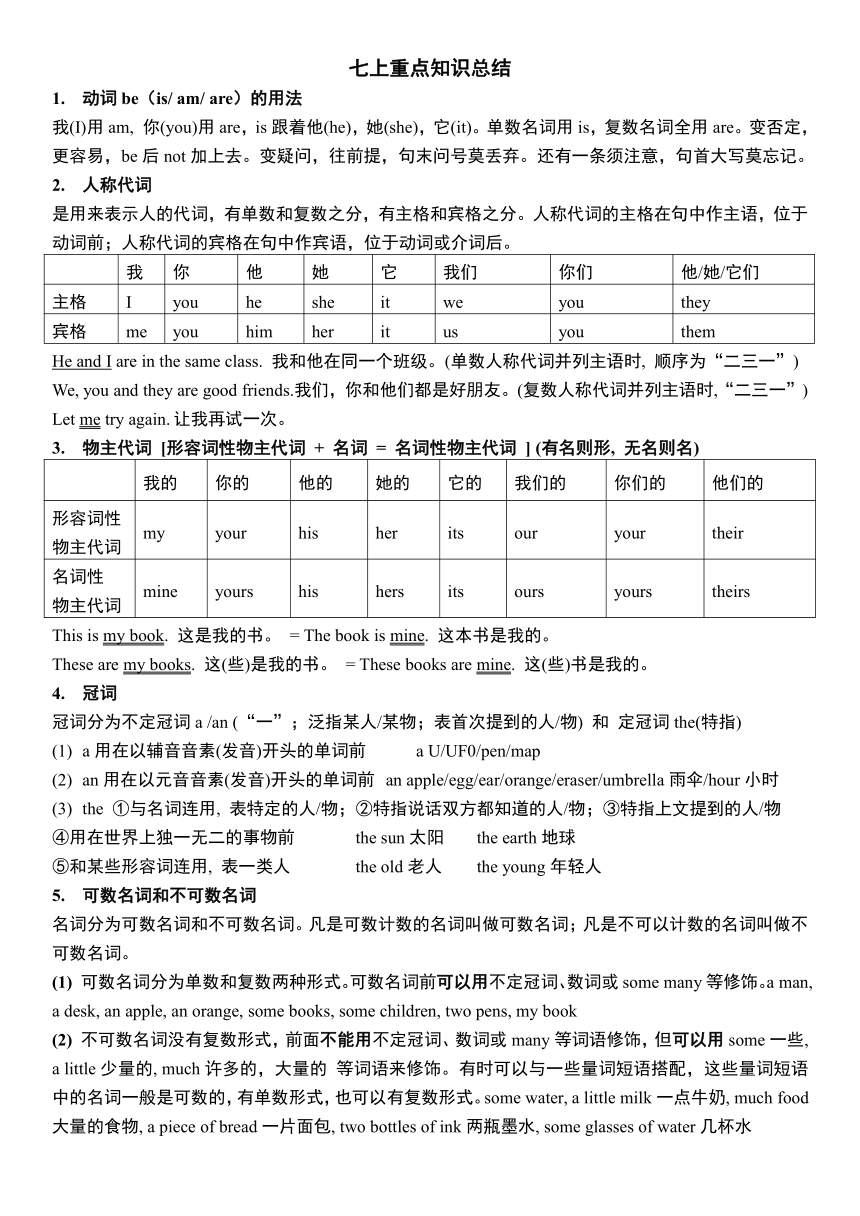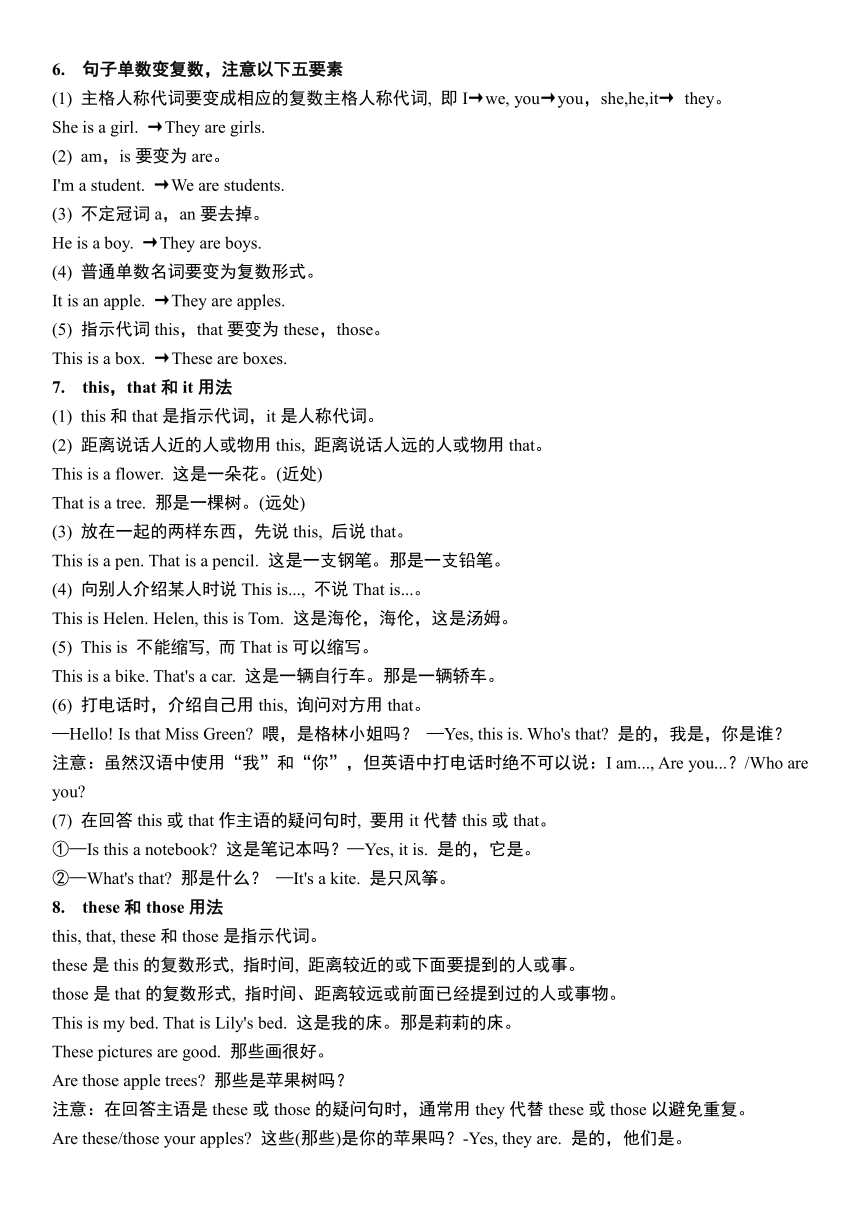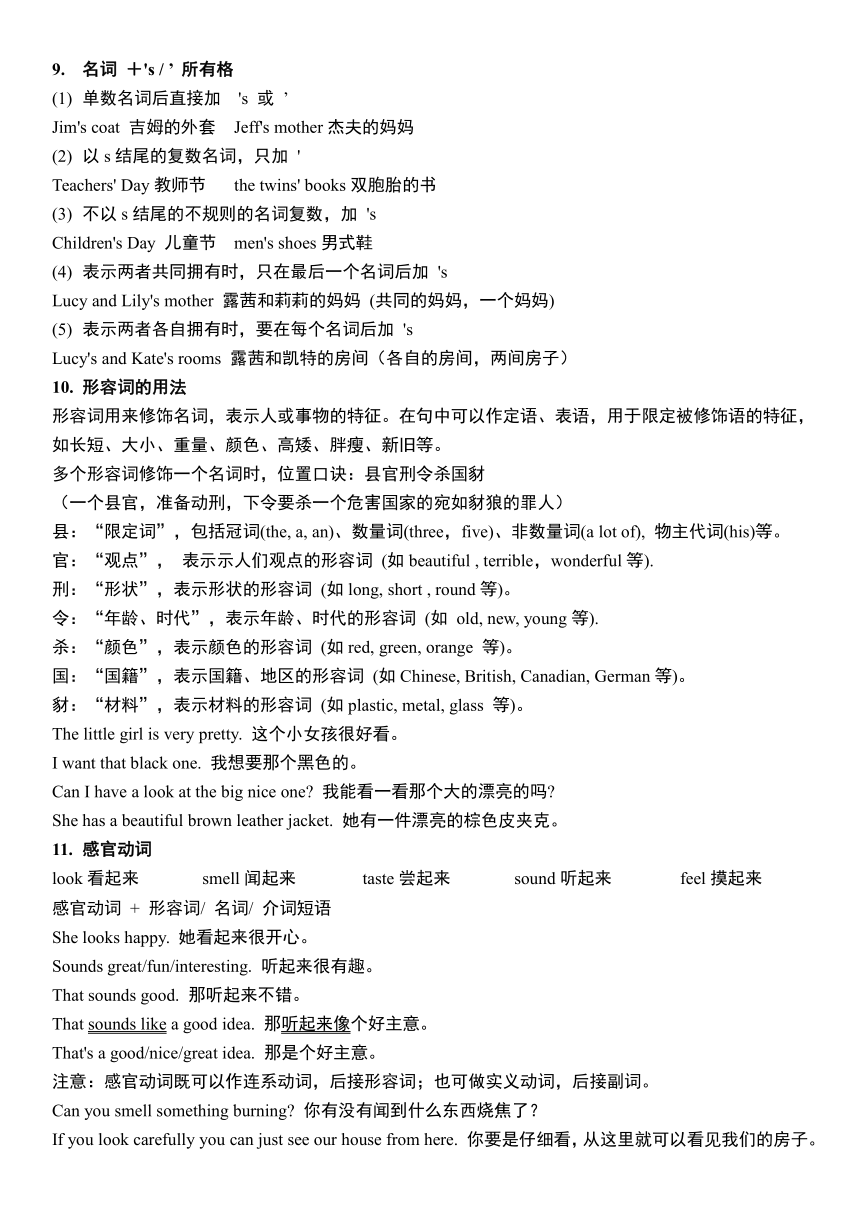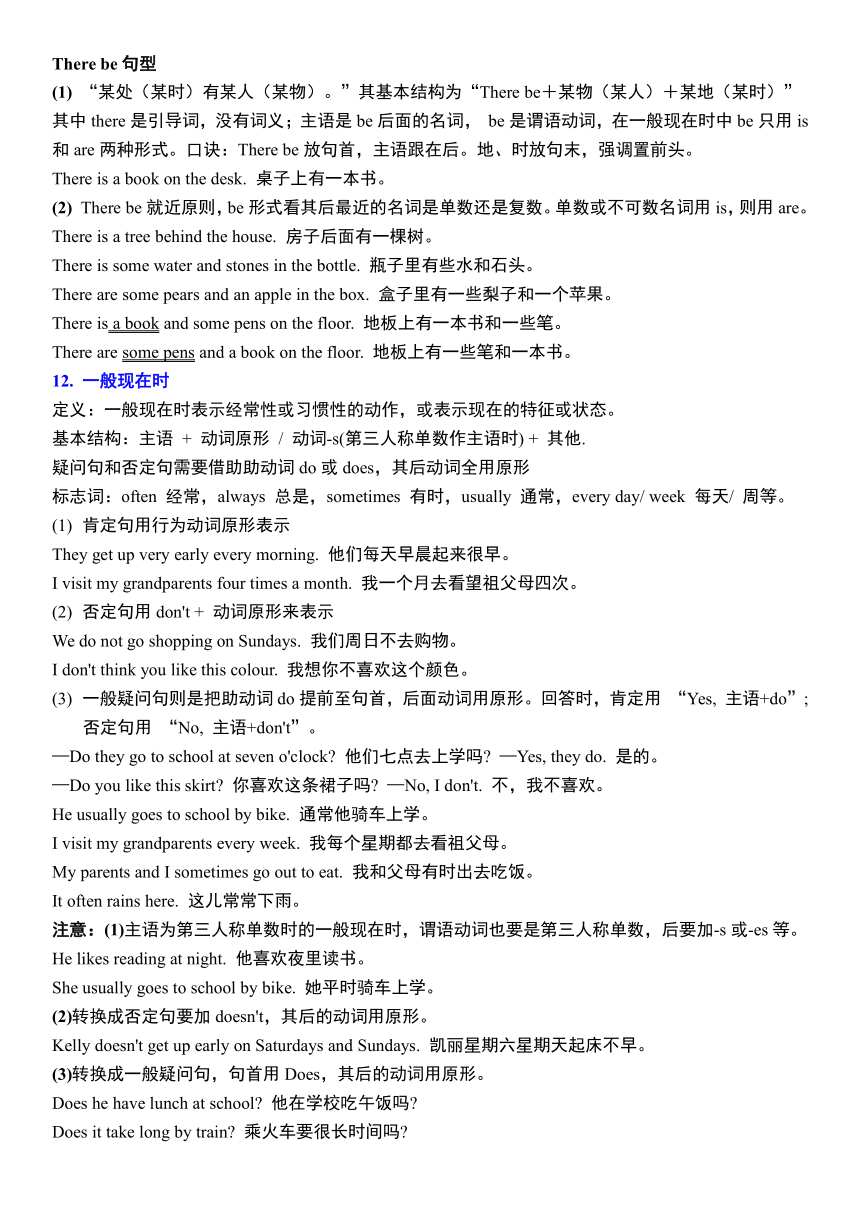2023-2024学年人教版七年级英语上册 期末重点语法总结
文档属性
| 名称 | 2023-2024学年人教版七年级英语上册 期末重点语法总结 |  | |
| 格式 | docx | ||
| 文件大小 | 35.8KB | ||
| 资源类型 | 教案 | ||
| 版本资源 | 人教新目标(Go for it)版 | ||
| 科目 | 英语 | ||
| 更新时间 | 2024-01-11 14:18:51 | ||
图片预览




文档简介
七上重点知识总结
动词be(is/ am/ are)的用法
我(I)用am, 你(you)用are,is跟着他(he),她(she),它(it)。单数名词用is,复数名词全用are。变否定,更容易,be后not加上去。变疑问,往前提,句末问号莫丢弃。还有一条须注意,句首大写莫忘记。
人称代词
是用来表示人的代词,有单数和复数之分,有主格和宾格之分。人称代词的主格在句中作主语,位于动词前;人称代词的宾格在句中作宾语,位于动词或介词后。
我 你 他 她 它 我们 你们 他/她/它们
主格 I you he she it we you they
宾格 me you him her it us you them
He and I are in the same class. 我和他在同一个班级。(单数人称代词并列主语时, 顺序为“二三一”)
We, you and they are good friends.我们,你和他们都是好朋友。(复数人称代词并列主语时,“二三一”)
Let me try again. 让我再试一次。
物主代词 [形容词性物主代词 + 名词 = 名词性物主代词 ] (有名则形, 无名则名)
我的 你的 他的 她的 它的 我们的 你们的 他们的
形容词性 物主代词 my your his her its our your their
名词性 物主代词 mine yours his hers its ours yours theirs
This is my book. 这是我的书。 = The book is mine. 这本书是我的。
These are my books. 这(些)是我的书。 = These books are mine. 这(些)书是我的。
冠词
冠词分为不定冠词a /an (“一”;泛指某人/某物;表首次提到的人/物) 和 定冠词the(特指)
a用在以辅音音素(发音)开头的单词前 a U/UF0/pen/map
an用在以元音音素(发音)开头的单词前 an apple/egg/ear/orange/eraser/umbrella雨伞/hour小时
the ①与名词连用, 表特定的人/物;②特指说话双方都知道的人/物;③特指上文提到的人/物
④用在世界上独一无二的事物前 the sun太阳 the earth地球
⑤和某些形容词连用, 表一类人 the old老人 the young年轻人
可数名词和不可数名词
名词分为可数名词和不可数名词。凡是可数计数的名词叫做可数名词;凡是不可以计数的名词叫做不可数名词。
可数名词分为单数和复数两种形式。可数名词前可以用不定冠词、数词或some many等修饰。a man, a desk, an apple, an orange, some books, some children, two pens, my book
不可数名词没有复数形式,前面不能用不定冠词、数词或many等词语修饰,但可以用some一些, a little少量的, much许多的,大量的 等词语来修饰。有时可以与一些量词短语搭配,这些量词短语中的名词一般是可数的,有单数形式,也可以有复数形式。some water, a little milk一点牛奶, much food大量的食物, a piece of bread一片面包, two bottles of ink两瓶墨水, some glasses of water几杯水
句子单数变复数,注意以下五要素
主格人称代词要变成相应的复数主格人称代词, 即I→we, you→you,she,he,it→ they。
She is a girl. →They are girls.
am,is要变为are。
I'm a student. →We are students.
不定冠词a,an要去掉。
He is a boy. →They are boys.
普通单数名词要变为复数形式。
It is an apple. →They are apples.
指示代词this,that要变为these,those。
This is a box. →These are boxes.
this,that和it用法
this和that是指示代词,it是人称代词。
距离说话人近的人或物用this, 距离说话人远的人或物用that。
This is a flower. 这是一朵花。(近处)
That is a tree. 那是一棵树。(远处)
放在一起的两样东西,先说this, 后说that。
This is a pen. That is a pencil. 这是一支钢笔。那是一支铅笔。
向别人介绍某人时说This is..., 不说That is...。
This is Helen. Helen, this is Tom. 这是海伦,海伦,这是汤姆。
This is 不能缩写, 而That is可以缩写。
This is a bike. That's a car. 这是一辆自行车。那是一辆轿车。
打电话时,介绍自己用this, 询问对方用that。
—Hello! Is that Miss Green 喂,是格林小姐吗? —Yes, this is. Who's that 是的,我是,你是谁?
注意:虽然汉语中使用“我”和“你”,但英语中打电话时绝不可以说:I am..., Are you...?/Who are you
在回答this或that作主语的疑问句时, 要用it代替this或that。
①—Is this a notebook 这是笔记本吗?—Yes, it is. 是的,它是。
②—What's that 那是什么? —It's a kite. 是只风筝。
these和those用法
this, that, these和those是指示代词。
these是this的复数形式, 指时间, 距离较近的或下面要提到的人或事。
those是that的复数形式, 指时间、距离较远或前面已经提到过的人或事物。
This is my bed. That is Lily's bed. 这是我的床。那是莉莉的床。
These pictures are good. 那些画很好。
Are those apple trees 那些是苹果树吗?
注意:在回答主语是these或those的疑问句时,通常用they代替these或those以避免重复。
Are these/those your apples 这些(那些)是你的苹果吗?-Yes, they are. 是的,他们是。
名词 +'s / ’ 所有格
单数名词后直接加 's 或 ’
Jim's coat 吉姆的外套 Jeff's mother杰夫的妈妈
以s结尾的复数名词,只加 '
Teachers' Day教师节 the twins' books双胞胎的书
不以s结尾的不规则的名词复数,加 's
Children's Day 儿童节 men's shoes男式鞋
表示两者共同拥有时,只在最后一个名词后加 's
Lucy and Lily's mother 露茜和莉莉的妈妈 (共同的妈妈,一个妈妈)
表示两者各自拥有时,要在每个名词后加 's
Lucy's and Kate's rooms 露茜和凯特的房间(各自的房间,两间房子)
形容词的用法
形容词用来修饰名词,表示人或事物的特征。在句中可以作定语、表语,用于限定被修饰语的特征,如长短、大小、重量、颜色、高矮、胖瘦、新旧等。
多个形容词修饰一个名词时,位置口诀:县官刑令杀国豺
(一个县官,准备动刑,下令要杀一个危害国家的宛如豺狼的罪人)
县:“限定词”,包括冠词(the, a, an)、数量词(three,five)、非数量词(a lot of), 物主代词(his)等。
官:“观点”, 表示示人们观点的形容词 (如beautiful , terrible,wonderful等).
刑:“形状”,表示形状的形容词 (如long, short , round等)。
令:“年龄、时代”,表示年龄、时代的形容词 (如 old, new, young等).
杀:“颜色”,表示颜色的形容词 (如red, green, orange 等)。
国:“国籍”,表示国籍、地区的形容词 (如Chinese, British, Canadian, German等)。
豺:“材料”,表示材料的形容词 (如plastic, metal, glass 等)。
The little girl is very pretty. 这个小女孩很好看。
I want that black one. 我想要那个黑色的。
Can I have a look at the big nice one 我能看一看那个大的漂亮的吗
She has a beautiful brown leather jacket. 她有一件漂亮的棕色皮夹克。
感官动词
look看起来 smell闻起来 taste尝起来 sound听起来 feel摸起来
感官动词 + 形容词/ 名词/ 介词短语
She looks happy. 她看起来很开心。
Sounds great/fun/interesting. 听起来很有趣。
That sounds good. 那听起来不错。
That sounds like a good idea. 那听起来像个好主意。
That's a good/nice/great idea. 那是个好主意。
注意:感官动词既可以作连系动词,后接形容词;也可做实义动词,后接副词。
Can you smell something burning 你有没有闻到什么东西烧焦了?
If you look carefully you can just see our house from here. 你要是仔细看,从这里就可以看见我们的房子。
There be句型
“某处(某时)有某人(某物)。”其基本结构为“There be+某物(某人)+某地(某时)”
其中there是引导词,没有词义;主语是be后面的名词, be是谓语动词,在一般现在时中be只用is和are两种形式。口诀:There be放句首,主语跟在后。地、时放句末,强调置前头。
There is a book on the desk. 桌子上有一本书。
There be就近原则,be形式看其后最近的名词是单数还是复数。单数或不可数名词用is,则用are。
There is a tree behind the house. 房子后面有一棵树。
There is some water and stones in the bottle. 瓶子里有些水和石头。
There are some pears and an apple in the box. 盒子里有一些梨子和一个苹果。
There is a book and some pens on the floor. 地板上有一本书和一些笔。
There are some pens and a book on the floor. 地板上有一些笔和一本书。
一般现在时
定义:一般现在时表示经常性或习惯性的动作,或表示现在的特征或状态。
基本结构:主语 + 动词原形 / 动词-s(第三人称单数作主语时) + 其他.
疑问句和否定句需要借助助动词do或does,其后动词全用原形
标志词:often 经常,always 总是,sometimes 有时,usually 通常,every day/ week 每天/ 周等。
肯定句用行为动词原形表示
They get up very early every morning. 他们每天早晨起来很早。
I visit my grandparents four times a month. 我一个月去看望祖父母四次。
否定句用don't + 动词原形来表示
We do not go shopping on Sundays. 我们周日不去购物。
I don't think you like this colour. 我想你不喜欢这个颜色。
一般疑问句则是把助动词do提前至句首,后面动词用原形。回答时,肯定用 “Yes, 主语+do”;否定句用 “No, 主语+don't”。
—Do they go to school at seven o'clock 他们七点去上学吗 —Yes, they do. 是的。
—Do you like this skirt 你喜欢这条裙子吗 —No, I don't. 不,我不喜欢。
He usually goes to school by bike. 通常他骑车上学。
I visit my grandparents every week. 我每个星期都去看祖父母。
My parents and I sometimes go out to eat. 我和父母有时出去吃饭。
It often rains here. 这儿常常下雨。
注意:(1)主语为第三人称单数时的一般现在时,谓语动词也要是第三人称单数,后要加-s或-es等。
He likes reading at night. 他喜欢夜里读书。
She usually goes to school by bike. 她平时骑车上学。
(2)转换成否定句要加doesn't,其后的动词用原形。
Kelly doesn't get up early on Saturdays and Sundays. 凯丽星期六星期天起床不早。
(3)转换成一般疑问句,句首用Does,其后的动词用原形。
Does he have lunch at school 他在学校吃午饭吗
Does it take long by train 乘火车要很长时间吗
like的用法
like用作及物动词,译为“喜欢”。
后接名词或代词,表示喜欢某人或某物。
I like the baby very much. 我非常喜欢这个小孩。
后接动名词(v. -ing),表示“喜欢做某事”,着重于习惯、爱好。
Tom likes playing football. 汤姆喜欢踢足球。
后接动词不定式(to do ),表示“偶尔地喜欢做某事”,着重于某次具体的行为。
I like reading, but I like to watch TV this evening. 我喜欢读书,但我今晚想看电视。
want用法
想干什么用want to do sth
They want to join the sports club. 他们想加入运动俱乐部。
第三人称单数作主语,want要作变化
①He wants to play basketball.
②Li Xia wants to play the piano.
变疑问句,否定句要借助助动词do或does.
①-Do you want to play soccer ball -Yes , I do . / No , I don't.
②-Does he want to go home by bus -Yes , he does . / No , he doesn't
have/ has的用法
动词have表示“有”,一般现在时有两种形式:have和has(单三),过去式had。
I have an apple and he has two bananas. 我有一个苹果,他有两个香蕉。
You have a new English teacher. 你们有了一个新的英语老师。
It has two big eyes. 它有一双大眼睛。
Julie and Jack have a nice car. 朱莉和杰克有一辆好看的车。
have/has与there be句型比较:两者都表示“有”,但用法不同。
前者表示所属关系,即表示“某人或某物有什么”,而后者表示存在,表示“某地有什么”。
They have some new books. 他们有一些新书。
There are some new books on their desks. 他们桌子上有一些新书。
She has a lot of pretty skirts. 她有很多漂亮的裙子。
There are a lot of pretty skirts in the shop. 商店里有很多漂亮的裙子。
have/ has的否定句,一般要加助动词do/ does,再加not构成,即don't have / doesn't have
She does not have a sister. 她没有姐姐。= She doesn’t have a sister.
一般疑问句“助动词Do/ Does + 主语 + have + 其他 ”,回答Yes, ... do/ does.或No, ... don't/ doesn't.
—Do you have a big house 他们的房子大吗 —No, they don't. 不,他们的房子不大。
—Does he have an eraser 他有橡皮吗 —Yes, he does. 他有的。
特殊疑问句由特殊疑问词 + 助动词do/ does + have (+状语)构成。
What do they have 他们有什么
What does he have 他有什么
How many telephones do they have 他们有几部电话
英语日期的表示法
英语中月份和星期名称都是专有名词,它们的首字母必须大写,并且前面无需用冠词。
英语表示日期,顺序为星期+月+日+年,日和年之间需用逗号隔开。August 2nd,2003 (2003.8.2)。
也可以用星期+日+月+年来表示。月和年之间需用逗号隔开。10th May,2003 (2003年5月10日)
日期前介词的使用:若指在哪一年或哪一月,则用介词in,若具体到某一天,则需用介词on。
时间的表达法
直读式,即直接读出时间数字
7: 05 seven five 8:16 eight sixteen
过、差式,即几点差几分,几点过几分。(30分及之前past,30分之后to)
1:25 twenty-five past one 2:30 half past two
3:43 seventeen to four 4:38 twenty-two to five
12小时制 6:00 a.m. 上午6点 8:20 p.m. 下午8点20分
24小时制 13:00 13点钟 22:15 22点15分
15分可用quarter 4:15 a quarter past four 5:45 a quarter to six
时间点前通常用at at 5 o'clock at 7:30 p.m.
祈使句
定义:表达说话人对对方的叮嘱、劝告、希望、禁止、请求或命令等。祈使句一般以动词原形开头,无时态和数的变化,句末用句号或感叹号,用降调。
肯定祈使句
动词原形 + 其他. Put away your things. 把你的东西收起来。
Please + 动词原形 + 其他. Please listen to me carefully!请仔细听我说! / Stand up, please.
Do(强调) + 动词原形 + 其他. Do come on time! 一定准时来!
Let us/ me + 动词原形 + 其他. Let's have another try. 让我们再试一次。
否定祈使句
Don't + 动词原形 + 其他. Don't worry. 别担心。/ Don't open the window. 不要打开窗户。
Please don't + 动词原形 + 其他. Please don't read in the sun. 请不要在阳光下读书。
No + sth./doing No photos! 禁止拍照! / No parking!禁止停车
Don't let sb + 动词原形 + 其他. Don't let him go there alone. 别让他一个人去那里。
= Let sb + not + 动词原形 + 其他. Let him not go there alone. 让他不要独自一人去那里。
祈使句回答
—Please remember to take the dog out for a walk every day. —Yes, I will
—Don't take your mobile phone to school. —Sorry, I won't
祈使句 + and/or 结果状语从句
Work harder, and you'll get good grades. 就会...= If you work harder, you'll get good grades.
Hurry up, or you'll be late for class. 否则..= If you don't hurry up, you'll be late for lass.
祈使句反问
Put away your things, will/won't you / Don't open the window, will you
Let's have another try, shall we / Let us have another try, will you
情态动词can的用法
can是情态动词,表示“能,会,可以,允许等”,后接动词原形,否定形式can not,可缩写为can't.
She can speak Japanese. 她会讲日语。
I can't remember his name. 我不记得他的名字了。
Can you spell your name 你会拼写你的名字吗
其他常见情态动词:can(could)、may(might)可能、must必须、need需要、shall将要、should应该
现在进行时态
定义:表示现在(说话瞬间)正在进行或发生的动作,或目前一段时间内或现阶段正在进行的活动。
结构:be动词(am, is, are) + 动词ing(其中be动词要与主语保持一致)
Mary is flying a kite in the park. 玛丽正在公园里放风筝。
Are they drawing the pictures now 他们正在画画吗
—What are you doing now 你现在在干什么 —I'm reading English. 我正在读英语。
标志词:now现在/look! 看/ listen! 听/ 通过上下文判断
She is cleaning her room now. 她正在打扫房间。
Look! The girl is dancing over there. 看!那个女孩在那里跳舞。
—Can you go and play games with me 你能和我们一起做游戏吗
—Can't you see I am doing my homework 你没看见我正在做作业吗
动词现在分词(动词ing形式)规则变化
1) 直接在动词后加ing
play—playing, do—doing, talk—talking, sing—singing
2) 以不发音的字母e结尾的动词,先去e,再加ing
make—making, write—writing, have—having, take—taking
3) 以重读闭音节结尾的动词且词尾只有一个辅音字母,应双写这个辅音字母,再加ing
run—running, stop—stopping, put—putting, swim—swimming
时间介词
at + 具体时刻(注意固定搭配:at noon在中午/ at night在夜间)
He gets up at half past seven every day. 他每天七点半起床。
in + 年/月/季节(固定搭配:in the morning/in the afternoon /in the evening 在早上/下午/晚上)
He was born in 2000. 他出生于2000年。
There are 31 days in May. 五月份有31天。
We can go swimming in summer. 夏天我们可以去游泳。
on + 具体某天(日期/星期);具体某日早中晚
What do you usually do on Monday 星期一你通常做什么
Parents take children to parks on June 1. 六月一日,家长们带着孩子去公园。
Do you sometimes go out to eat on Friday evening 有时你星期五晚上出去吃饭吗
注意:在this, last, next, every等词前面既不加介词,也不用冠词。
What are you doing this afternoon 今天下午你做什么
He visits his grandma every Friday. 他每个星期五都去看望祖母。
动词be(is/ am/ are)的用法
我(I)用am, 你(you)用are,is跟着他(he),她(she),它(it)。单数名词用is,复数名词全用are。变否定,更容易,be后not加上去。变疑问,往前提,句末问号莫丢弃。还有一条须注意,句首大写莫忘记。
人称代词
是用来表示人的代词,有单数和复数之分,有主格和宾格之分。人称代词的主格在句中作主语,位于动词前;人称代词的宾格在句中作宾语,位于动词或介词后。
我 你 他 她 它 我们 你们 他/她/它们
主格 I you he she it we you they
宾格 me you him her it us you them
He and I are in the same class. 我和他在同一个班级。(单数人称代词并列主语时, 顺序为“二三一”)
We, you and they are good friends.我们,你和他们都是好朋友。(复数人称代词并列主语时,“二三一”)
Let me try again. 让我再试一次。
物主代词 [形容词性物主代词 + 名词 = 名词性物主代词 ] (有名则形, 无名则名)
我的 你的 他的 她的 它的 我们的 你们的 他们的
形容词性 物主代词 my your his her its our your their
名词性 物主代词 mine yours his hers its ours yours theirs
This is my book. 这是我的书。 = The book is mine. 这本书是我的。
These are my books. 这(些)是我的书。 = These books are mine. 这(些)书是我的。
冠词
冠词分为不定冠词a /an (“一”;泛指某人/某物;表首次提到的人/物) 和 定冠词the(特指)
a用在以辅音音素(发音)开头的单词前 a U/UF0/pen/map
an用在以元音音素(发音)开头的单词前 an apple/egg/ear/orange/eraser/umbrella雨伞/hour小时
the ①与名词连用, 表特定的人/物;②特指说话双方都知道的人/物;③特指上文提到的人/物
④用在世界上独一无二的事物前 the sun太阳 the earth地球
⑤和某些形容词连用, 表一类人 the old老人 the young年轻人
可数名词和不可数名词
名词分为可数名词和不可数名词。凡是可数计数的名词叫做可数名词;凡是不可以计数的名词叫做不可数名词。
可数名词分为单数和复数两种形式。可数名词前可以用不定冠词、数词或some many等修饰。a man, a desk, an apple, an orange, some books, some children, two pens, my book
不可数名词没有复数形式,前面不能用不定冠词、数词或many等词语修饰,但可以用some一些, a little少量的, much许多的,大量的 等词语来修饰。有时可以与一些量词短语搭配,这些量词短语中的名词一般是可数的,有单数形式,也可以有复数形式。some water, a little milk一点牛奶, much food大量的食物, a piece of bread一片面包, two bottles of ink两瓶墨水, some glasses of water几杯水
句子单数变复数,注意以下五要素
主格人称代词要变成相应的复数主格人称代词, 即I→we, you→you,she,he,it→ they。
She is a girl. →They are girls.
am,is要变为are。
I'm a student. →We are students.
不定冠词a,an要去掉。
He is a boy. →They are boys.
普通单数名词要变为复数形式。
It is an apple. →They are apples.
指示代词this,that要变为these,those。
This is a box. →These are boxes.
this,that和it用法
this和that是指示代词,it是人称代词。
距离说话人近的人或物用this, 距离说话人远的人或物用that。
This is a flower. 这是一朵花。(近处)
That is a tree. 那是一棵树。(远处)
放在一起的两样东西,先说this, 后说that。
This is a pen. That is a pencil. 这是一支钢笔。那是一支铅笔。
向别人介绍某人时说This is..., 不说That is...。
This is Helen. Helen, this is Tom. 这是海伦,海伦,这是汤姆。
This is 不能缩写, 而That is可以缩写。
This is a bike. That's a car. 这是一辆自行车。那是一辆轿车。
打电话时,介绍自己用this, 询问对方用that。
—Hello! Is that Miss Green 喂,是格林小姐吗? —Yes, this is. Who's that 是的,我是,你是谁?
注意:虽然汉语中使用“我”和“你”,但英语中打电话时绝不可以说:I am..., Are you...?/Who are you
在回答this或that作主语的疑问句时, 要用it代替this或that。
①—Is this a notebook 这是笔记本吗?—Yes, it is. 是的,它是。
②—What's that 那是什么? —It's a kite. 是只风筝。
these和those用法
this, that, these和those是指示代词。
these是this的复数形式, 指时间, 距离较近的或下面要提到的人或事。
those是that的复数形式, 指时间、距离较远或前面已经提到过的人或事物。
This is my bed. That is Lily's bed. 这是我的床。那是莉莉的床。
These pictures are good. 那些画很好。
Are those apple trees 那些是苹果树吗?
注意:在回答主语是these或those的疑问句时,通常用they代替these或those以避免重复。
Are these/those your apples 这些(那些)是你的苹果吗?-Yes, they are. 是的,他们是。
名词 +'s / ’ 所有格
单数名词后直接加 's 或 ’
Jim's coat 吉姆的外套 Jeff's mother杰夫的妈妈
以s结尾的复数名词,只加 '
Teachers' Day教师节 the twins' books双胞胎的书
不以s结尾的不规则的名词复数,加 's
Children's Day 儿童节 men's shoes男式鞋
表示两者共同拥有时,只在最后一个名词后加 's
Lucy and Lily's mother 露茜和莉莉的妈妈 (共同的妈妈,一个妈妈)
表示两者各自拥有时,要在每个名词后加 's
Lucy's and Kate's rooms 露茜和凯特的房间(各自的房间,两间房子)
形容词的用法
形容词用来修饰名词,表示人或事物的特征。在句中可以作定语、表语,用于限定被修饰语的特征,如长短、大小、重量、颜色、高矮、胖瘦、新旧等。
多个形容词修饰一个名词时,位置口诀:县官刑令杀国豺
(一个县官,准备动刑,下令要杀一个危害国家的宛如豺狼的罪人)
县:“限定词”,包括冠词(the, a, an)、数量词(three,five)、非数量词(a lot of), 物主代词(his)等。
官:“观点”, 表示示人们观点的形容词 (如beautiful , terrible,wonderful等).
刑:“形状”,表示形状的形容词 (如long, short , round等)。
令:“年龄、时代”,表示年龄、时代的形容词 (如 old, new, young等).
杀:“颜色”,表示颜色的形容词 (如red, green, orange 等)。
国:“国籍”,表示国籍、地区的形容词 (如Chinese, British, Canadian, German等)。
豺:“材料”,表示材料的形容词 (如plastic, metal, glass 等)。
The little girl is very pretty. 这个小女孩很好看。
I want that black one. 我想要那个黑色的。
Can I have a look at the big nice one 我能看一看那个大的漂亮的吗
She has a beautiful brown leather jacket. 她有一件漂亮的棕色皮夹克。
感官动词
look看起来 smell闻起来 taste尝起来 sound听起来 feel摸起来
感官动词 + 形容词/ 名词/ 介词短语
She looks happy. 她看起来很开心。
Sounds great/fun/interesting. 听起来很有趣。
That sounds good. 那听起来不错。
That sounds like a good idea. 那听起来像个好主意。
That's a good/nice/great idea. 那是个好主意。
注意:感官动词既可以作连系动词,后接形容词;也可做实义动词,后接副词。
Can you smell something burning 你有没有闻到什么东西烧焦了?
If you look carefully you can just see our house from here. 你要是仔细看,从这里就可以看见我们的房子。
There be句型
“某处(某时)有某人(某物)。”其基本结构为“There be+某物(某人)+某地(某时)”
其中there是引导词,没有词义;主语是be后面的名词, be是谓语动词,在一般现在时中be只用is和are两种形式。口诀:There be放句首,主语跟在后。地、时放句末,强调置前头。
There is a book on the desk. 桌子上有一本书。
There be就近原则,be形式看其后最近的名词是单数还是复数。单数或不可数名词用is,则用are。
There is a tree behind the house. 房子后面有一棵树。
There is some water and stones in the bottle. 瓶子里有些水和石头。
There are some pears and an apple in the box. 盒子里有一些梨子和一个苹果。
There is a book and some pens on the floor. 地板上有一本书和一些笔。
There are some pens and a book on the floor. 地板上有一些笔和一本书。
一般现在时
定义:一般现在时表示经常性或习惯性的动作,或表示现在的特征或状态。
基本结构:主语 + 动词原形 / 动词-s(第三人称单数作主语时) + 其他.
疑问句和否定句需要借助助动词do或does,其后动词全用原形
标志词:often 经常,always 总是,sometimes 有时,usually 通常,every day/ week 每天/ 周等。
肯定句用行为动词原形表示
They get up very early every morning. 他们每天早晨起来很早。
I visit my grandparents four times a month. 我一个月去看望祖父母四次。
否定句用don't + 动词原形来表示
We do not go shopping on Sundays. 我们周日不去购物。
I don't think you like this colour. 我想你不喜欢这个颜色。
一般疑问句则是把助动词do提前至句首,后面动词用原形。回答时,肯定用 “Yes, 主语+do”;否定句用 “No, 主语+don't”。
—Do they go to school at seven o'clock 他们七点去上学吗 —Yes, they do. 是的。
—Do you like this skirt 你喜欢这条裙子吗 —No, I don't. 不,我不喜欢。
He usually goes to school by bike. 通常他骑车上学。
I visit my grandparents every week. 我每个星期都去看祖父母。
My parents and I sometimes go out to eat. 我和父母有时出去吃饭。
It often rains here. 这儿常常下雨。
注意:(1)主语为第三人称单数时的一般现在时,谓语动词也要是第三人称单数,后要加-s或-es等。
He likes reading at night. 他喜欢夜里读书。
She usually goes to school by bike. 她平时骑车上学。
(2)转换成否定句要加doesn't,其后的动词用原形。
Kelly doesn't get up early on Saturdays and Sundays. 凯丽星期六星期天起床不早。
(3)转换成一般疑问句,句首用Does,其后的动词用原形。
Does he have lunch at school 他在学校吃午饭吗
Does it take long by train 乘火车要很长时间吗
like的用法
like用作及物动词,译为“喜欢”。
后接名词或代词,表示喜欢某人或某物。
I like the baby very much. 我非常喜欢这个小孩。
后接动名词(v. -ing),表示“喜欢做某事”,着重于习惯、爱好。
Tom likes playing football. 汤姆喜欢踢足球。
后接动词不定式(to do ),表示“偶尔地喜欢做某事”,着重于某次具体的行为。
I like reading, but I like to watch TV this evening. 我喜欢读书,但我今晚想看电视。
want用法
想干什么用want to do sth
They want to join the sports club. 他们想加入运动俱乐部。
第三人称单数作主语,want要作变化
①He wants to play basketball.
②Li Xia wants to play the piano.
变疑问句,否定句要借助助动词do或does.
①-Do you want to play soccer ball -Yes , I do . / No , I don't.
②-Does he want to go home by bus -Yes , he does . / No , he doesn't
have/ has的用法
动词have表示“有”,一般现在时有两种形式:have和has(单三),过去式had。
I have an apple and he has two bananas. 我有一个苹果,他有两个香蕉。
You have a new English teacher. 你们有了一个新的英语老师。
It has two big eyes. 它有一双大眼睛。
Julie and Jack have a nice car. 朱莉和杰克有一辆好看的车。
have/has与there be句型比较:两者都表示“有”,但用法不同。
前者表示所属关系,即表示“某人或某物有什么”,而后者表示存在,表示“某地有什么”。
They have some new books. 他们有一些新书。
There are some new books on their desks. 他们桌子上有一些新书。
She has a lot of pretty skirts. 她有很多漂亮的裙子。
There are a lot of pretty skirts in the shop. 商店里有很多漂亮的裙子。
have/ has的否定句,一般要加助动词do/ does,再加not构成,即don't have / doesn't have
She does not have a sister. 她没有姐姐。= She doesn’t have a sister.
一般疑问句“助动词Do/ Does + 主语 + have + 其他 ”,回答Yes, ... do/ does.或No, ... don't/ doesn't.
—Do you have a big house 他们的房子大吗 —No, they don't. 不,他们的房子不大。
—Does he have an eraser 他有橡皮吗 —Yes, he does. 他有的。
特殊疑问句由特殊疑问词 + 助动词do/ does + have (+状语)构成。
What do they have 他们有什么
What does he have 他有什么
How many telephones do they have 他们有几部电话
英语日期的表示法
英语中月份和星期名称都是专有名词,它们的首字母必须大写,并且前面无需用冠词。
英语表示日期,顺序为星期+月+日+年,日和年之间需用逗号隔开。August 2nd,2003 (2003.8.2)。
也可以用星期+日+月+年来表示。月和年之间需用逗号隔开。10th May,2003 (2003年5月10日)
日期前介词的使用:若指在哪一年或哪一月,则用介词in,若具体到某一天,则需用介词on。
时间的表达法
直读式,即直接读出时间数字
7: 05 seven five 8:16 eight sixteen
过、差式,即几点差几分,几点过几分。(30分及之前past,30分之后to)
1:25 twenty-five past one 2:30 half past two
3:43 seventeen to four 4:38 twenty-two to five
12小时制 6:00 a.m. 上午6点 8:20 p.m. 下午8点20分
24小时制 13:00 13点钟 22:15 22点15分
15分可用quarter 4:15 a quarter past four 5:45 a quarter to six
时间点前通常用at at 5 o'clock at 7:30 p.m.
祈使句
定义:表达说话人对对方的叮嘱、劝告、希望、禁止、请求或命令等。祈使句一般以动词原形开头,无时态和数的变化,句末用句号或感叹号,用降调。
肯定祈使句
动词原形 + 其他. Put away your things. 把你的东西收起来。
Please + 动词原形 + 其他. Please listen to me carefully!请仔细听我说! / Stand up, please.
Do(强调) + 动词原形 + 其他. Do come on time! 一定准时来!
Let us/ me + 动词原形 + 其他. Let's have another try. 让我们再试一次。
否定祈使句
Don't + 动词原形 + 其他. Don't worry. 别担心。/ Don't open the window. 不要打开窗户。
Please don't + 动词原形 + 其他. Please don't read in the sun. 请不要在阳光下读书。
No + sth./doing No photos! 禁止拍照! / No parking!禁止停车
Don't let sb + 动词原形 + 其他. Don't let him go there alone. 别让他一个人去那里。
= Let sb + not + 动词原形 + 其他. Let him not go there alone. 让他不要独自一人去那里。
祈使句回答
—Please remember to take the dog out for a walk every day. —Yes, I will
—Don't take your mobile phone to school. —Sorry, I won't
祈使句 + and/or 结果状语从句
Work harder, and you'll get good grades. 就会...= If you work harder, you'll get good grades.
Hurry up, or you'll be late for class. 否则..= If you don't hurry up, you'll be late for lass.
祈使句反问
Put away your things, will/won't you / Don't open the window, will you
Let's have another try, shall we / Let us have another try, will you
情态动词can的用法
can是情态动词,表示“能,会,可以,允许等”,后接动词原形,否定形式can not,可缩写为can't.
She can speak Japanese. 她会讲日语。
I can't remember his name. 我不记得他的名字了。
Can you spell your name 你会拼写你的名字吗
其他常见情态动词:can(could)、may(might)可能、must必须、need需要、shall将要、should应该
现在进行时态
定义:表示现在(说话瞬间)正在进行或发生的动作,或目前一段时间内或现阶段正在进行的活动。
结构:be动词(am, is, are) + 动词ing(其中be动词要与主语保持一致)
Mary is flying a kite in the park. 玛丽正在公园里放风筝。
Are they drawing the pictures now 他们正在画画吗
—What are you doing now 你现在在干什么 —I'm reading English. 我正在读英语。
标志词:now现在/look! 看/ listen! 听/ 通过上下文判断
She is cleaning her room now. 她正在打扫房间。
Look! The girl is dancing over there. 看!那个女孩在那里跳舞。
—Can you go and play games with me 你能和我们一起做游戏吗
—Can't you see I am doing my homework 你没看见我正在做作业吗
动词现在分词(动词ing形式)规则变化
1) 直接在动词后加ing
play—playing, do—doing, talk—talking, sing—singing
2) 以不发音的字母e结尾的动词,先去e,再加ing
make—making, write—writing, have—having, take—taking
3) 以重读闭音节结尾的动词且词尾只有一个辅音字母,应双写这个辅音字母,再加ing
run—running, stop—stopping, put—putting, swim—swimming
时间介词
at + 具体时刻(注意固定搭配:at noon在中午/ at night在夜间)
He gets up at half past seven every day. 他每天七点半起床。
in + 年/月/季节(固定搭配:in the morning/in the afternoon /in the evening 在早上/下午/晚上)
He was born in 2000. 他出生于2000年。
There are 31 days in May. 五月份有31天。
We can go swimming in summer. 夏天我们可以去游泳。
on + 具体某天(日期/星期);具体某日早中晚
What do you usually do on Monday 星期一你通常做什么
Parents take children to parks on June 1. 六月一日,家长们带着孩子去公园。
Do you sometimes go out to eat on Friday evening 有时你星期五晚上出去吃饭吗
注意:在this, last, next, every等词前面既不加介词,也不用冠词。
What are you doing this afternoon 今天下午你做什么
He visits his grandma every Friday. 他每个星期五都去看望祖母。
同课章节目录
